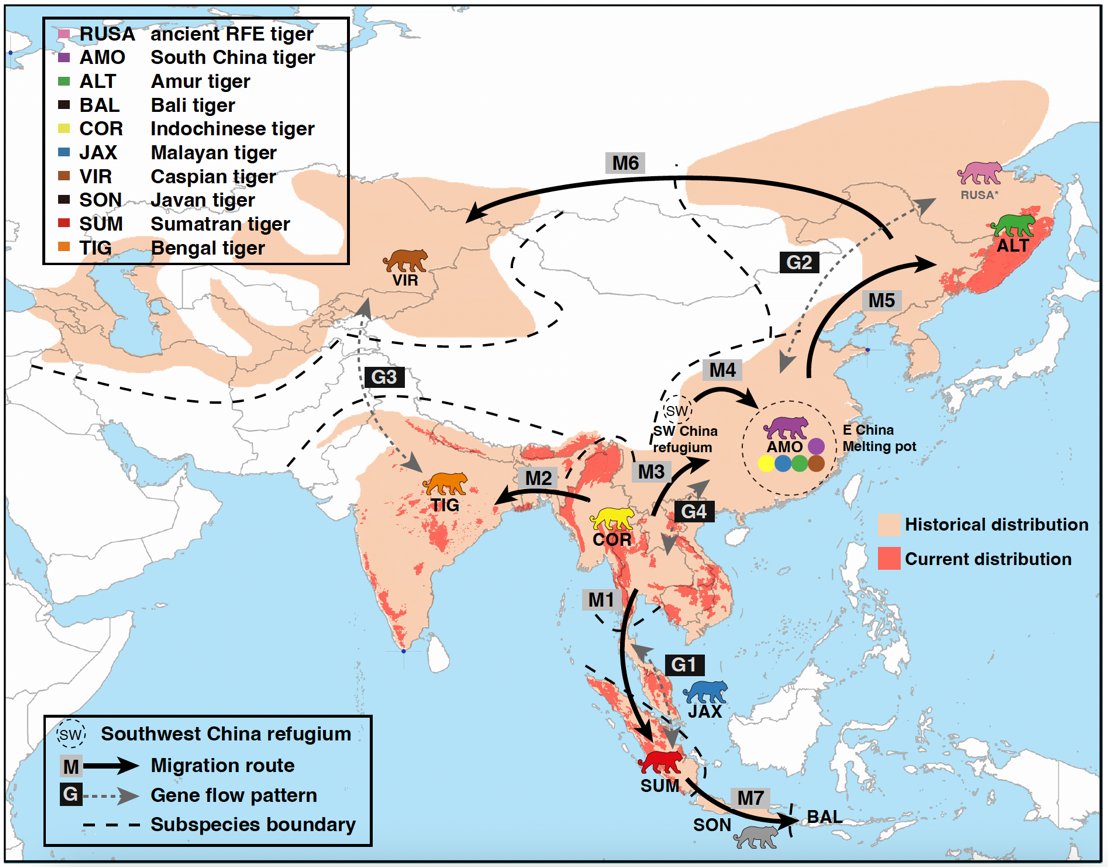

South China tiger at Shanghai Zoo. Picture: Sun Ge
Tigers are one of the world's most visible flagship species and face a serious conservation crisis. Among the nine modern tiger subspecies, the Bali tiger, Caspian tiger and Javan tiger are completely extinct; the South China tiger has no trace in the wild; the Siberian tiger, Indochinese tiger, Malayan tiger, Bengal tiger and Sumatran tiger are all endangered.
At about 23:00 on August 31, Beijing time, a paper published online in the international academic journal "Nature Ecology & Evolution" stated that using ancient DNA methods, ancient tigers from more than 60 copies that were ten thousand years old to a century-old scale were Genomic information was obtained from the samples, confirming the uniqueness of the South China tiger subspecies; proving for the first time that China is a "gene melting pot" in the history of tiger evolution ; and summarizing previously published modern tiger data to comprehensively elaborate on the ancient and modern genome levels The genetic origins and evolutionary history of tiger populations across the Asian continent.
One of the corresponding authors of the aforementioned paper is Luo Shujin, a researcher at the School of Life Sciences of Peking University, the State Key Laboratory of Protein and Plant Gene Research, the Peking University-Tsinghua Joint Center for Life Sciences, and the Ecological Research Center.
From 2004 to the present, Luo Shujin's team has been committed to the study of the evolutionary genetics of tigers, discovered and named a new subspecies of the Malayan tiger, revealed the genetic mechanism of tiger coat color, and confirmed the differences between subspecies at the genome-wide level.
Is the South China tiger a unique subspecies?
The aforementioned paper stated that early mitochondrial DNA analysis showed that in addition to its own unique branch lines, captive South China tigers also contain maternal genetic information from other subspecies, and the source is questionable. Because South China tigers in captivity cannot represent the former wild population, they have become the most ambiguous group of living tiger subspecies. Is the genetic uniqueness of the South China tiger established?
After 20 years, the collaborative team collected 33 museum samples with clear geographical origins from all over the world, including the type specimen when the South China tiger subspecies was named in 1905, forming the most comprehensive South China tiger genetic resource library to date, from which 18 samples were obtained. Whole genome and 15 partial genome data.
Based on nuclear genome analysis, researchers found that all South China tigers cluster into one branch, showing the uniqueness of their genomes and supporting the classification status of the subspecies, thereby resolving years of unclear questions about the status of South China tigers.
However, the South China tiger's maternally inherited mitochondria show a multi-lineage origin, reflecting its unique population history.
Habitat reconstruction using ecological niche models showed that the mountains of southwestern China were one of the refuges for late Pleistocene tigers , allowing the mitochondrial relict lineage that currently only exists in South China tigers to continue to exist. With the post-glacial climate changes and the restoration of suitable habitats, ancient tiger populations carrying multiple genetic lines from the southwest region in the west and the Indochina peninsula in the south met and merged in eastern China , eventually forming a genetically unique modern tiger population. South China tiger.
Among them, the mountainous areas of southwestern China are one of the most important biodiversity hotspots in the world, with extremely complex terrain and home to a variety of rare species.

China was once an ice age refuge and a "genetic melting pot" in the history of tiger evolution. It was of great significance to the formation of tiger distribution patterns. Ancient tiger genetic lines from multiple origins met and merged here to form the South China tiger subspecies, which further spread to Asian continent, forming Siberian tiger and Caspian tiger.
Genetic melting pot: spreading from eastern China to the entire Asian continent
Luo Shujin said that the oldest known tiger fossil is 2 to 3 million years old, which means that as a species, tigers have a history of 2 to 3 million years. Tigers originated in Asia and have never left Asia, but the specific place of origin cannot be determined.
The latest published research also pointed out for the first time that tigers migrated and spread further from eastern China and continued their journey across the Asian continent.
Population genome analysis further found that the ancient Far Eastern tiger population 10,000 years ago was different from the modern Siberian tiger. The former also carried genetic information similar to the unique mitochondrial branch of the South China tiger, which indicates that the tiger migration from China to Northeast Asia may have gone through It spread many times, and the last spread formed the modern Siberian tiger.
This study also addresses the question of the evolutionary origins of the extinct Caspian tiger. This is the only population on the Asian continent that is not geographically related to any other tiger. Studies have shown that the Caspian tiger has unique genetic diversity and clear subspecies classification. It may have originated from the ancient tiger population in Northeast Asia, crossed the Siberian Plain westward, arrived in Central Asia, and then passed through the genes of the Bengal tiger from the southern Indian subcontinent. communication, forming the modern Caspian tiger.